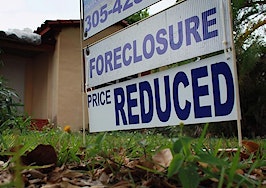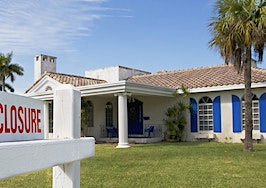As of the third quarter of 2020, roughly 216,000 homes are in the process of foreclosure, with 3.7 percent of those homes sitting empty as “zombie foreclosures.” While the total number of properties in foreclosure is down 16 percent from the second quarter, zombie foreclosures have increased from 3 percent the previous quarter, according to Attom Data Solutions’ Q3 2020 Vacant Property and Zombie Foreclosure Report.
About 1.5 million residential properties in the U.S., or 1.6 percent of all homes, are currently sitting vacant.
For the past several months, lenders have been prohibited from foreclosing on government-backed mortgages through the CARES Act. However, that ban will expire on August 31, and will impact about 70 percent of home loans in the U.S.
“Abandoned homes in foreclosure remain little more than a spot on the radar screen in most parts of the United States, posing few, if any, problems from neighborhood to neighborhood,” Todd Teta, chief product officer with Attom Data Solutions, said in a statement. “But the latest numbers do throw a small potential red flag into the air, given the increase in the percentage of zombie foreclosures.”
Regional breakdown
The Midwest and South have the highest zombie foreclosure rates overall. States where zombie foreclosure rates have exceeded the national rate include Kansas (15 percent), Missouri (11.2 percent), Georgia (11 percent), Kentucky (10.7 percent) and Tennessee (10.3 percent).
Those states where zombie foreclosure rates fall below the national level are largely congregated in the Northeast and West, including in Utah (1.1 percent), Idaho (1.2 percent), New Jersey (1.6 percent), Colorado (1.8 percent) and California (2 percent).
In every state but Hawaii, as well as in the District of Columbia, zombie foreclosure rates increased between the second and third quarters. States that saw the largest increases included Kansas (rose from 7.4 percent to 15 percent of all properties in foreclosure), Missouri (rose from 4 percent to 11.2 percent), Georgia (rose from 3.9 percent to 11 percent), Kentucky (rose from 3.9 percent to 10.7 percent) and Nebraska (rose from 4 percent to 10.3 percent).
In terms of actual number count, New York continues to have the highest number of zombie properties at 2,136, followed by Florida (1,028), Illinois (971), Ohio (887) and New Jersey (356).
At the metro level
Out of the 158 metro areas with at least 100,000 residential properties during the third quarter, metros with the highest zombie foreclosure rates include Peoria, Illinois (16.4 percent of properties in the process of foreclosure); Wichita, Kansas (15.3 percent); Kansas City, Missouri (13.4 percent); Omaha, Nebraska (12.7 percent); and Cleveland (12.6 percent).
In larger metro areas containing at least 500,000 residential properties, the lowest zombie foreclosure rates are found in Austin, Texas (0 percent); San Francisco (0.7 percent); Philadelphia (1.6 percent); Los Angeles (1.7 percent); and Charlotte, North Carolina (1.8 percent).
Countywide
Counties with at least 500 properties in foreclosure with the highest zombie foreclosure rates include Cuyahoga County (Cleveland), Ohio (14.1 percent); Broome County (Binghamton), New York (10.9 percent); Onondaga County (Syracuse), New York (10 percent); Pinellas County (Clearwater), Florida (8.5 percent); and Summit County (Akron), Ohio (7.8 percent).












